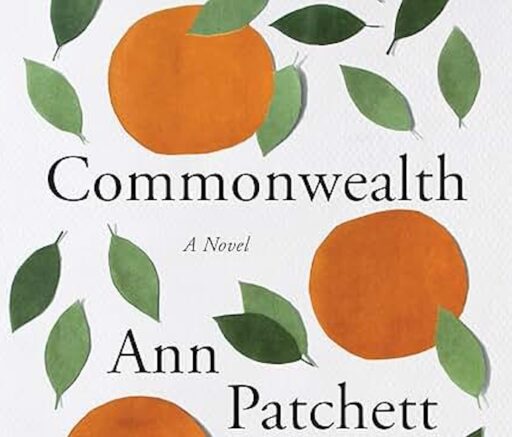Ann Patchett’s 2016 novel Commonwealth is a marvel of combinations and re-combinations—among the characters as well as the time frames.
There are ten main characters: two married couples (Fix and Beverly Keating, Bert and Teresa Cousins) plus the Keating girls (Caroline and Franny) and the Cousins kids (Cal, Holly, Jeannette, and Albie—short for Albert). The first re-combination is when the two couples divorce, with Beverly and Bert then marrying. The kids then shuttle back and forth between the Virginia home of Bert and Beverly and the California homes of Teresa and of Fix (who eventually marries a Marjorie). By the novel’s end, Bert has been married and divorced (matched up and unmatched) three times. Then when the kids have grown up, they do their own mixing and matching. Franny, for instance, has a long affair with a famous (fictional) novelist, then leaves him to marry a Guinean named Kumar.
Another sort of mixing is the varying accounts of an event depending on whose point of view we’re getting it from. Take the episode that leads to Cal’s early death. Allergic to bee stings, Cal always carries Benadryl with him. But on one of the kids’ outings, Albie is being such a pest that someone—Cal himself or one of the other kids there, depending on who’s recounting the event—give his Benadryl to the hyper Albie, to put him to sleep. Cal is stung by a bee and dies.
So goes the mixing and matching among characters. As for time frames, the novel covers five decades in the characters’ lives, but in a mishmash of orders. The opening chapter is chronologically apt: it recounts the Keatings’ christening party for baby Franny. But then with Chapter 2, here is Franny keeping Fix company during his chemotherapy when he’s in his eighties—which turns out to be near the end of the novel’s chronology. Then in Chapter 4, Fix’s kids are young and he, a policeman, decides to go to law school.
Other mixed-up chronologies abound. Teresa dies in Chapter 7, but visits Holly in Switzerland in Chapter 8. Jeanette is an adult at the start of Chapter 5, married to Fodé and with a baby; later in the chapter she’s a child living with her mom Teresa. Albie is fifteen in Chapter 6, though Chapter 5 had followed him from ages ten to twenty-eight.
And although early in Chapter 5, “the fire” is alluded to with respect to Albie, it’s not until later in the chapter that we learn what this fire is. Albie and his three high school friends, calling themselves The Goddamn Boys on Bikes, delight in getting into trouble. But one day unplanned trouble seeks them out. It’s a Saturday, when they sneak into their school, and in the art room Albie—who has taken a liking to striking matches—drops a lit match into a trash can without noticing the crumpled papers at the can’s bottom. Fire leaps up and spreads through the room as the boys flee.
The novel’s final chapter is, in a nice rounding off, in its chronological place: Franny, her husband Kumar, and their two kids (from Kumar’s first marriage) are at a Christmas party at the home of Beverly and her latest husband, Jack Dine. But, appropriately for this book, Franny has a couple of flashbacks. The first is to when she was a younger adult and got re-acquainted with Kumar at the bar where she was working and where she’d first met the famous novelist. Her second flashback is to when she was a teenager looking for Albie and finding him outside smoking pot. This flashback continues for three pages, after which just a single short final paragraph returns us to the narrative present. And even here, what Franny is thinking of is that teenage event with Albie. So, appropriately for this novel of mixed-up time frames, it ends in both the present and the past.
Amazingly, none of this jumbling of time frames is confusing for the reader. Patchett always gives clues, at the start of a new time period, of where in the novel’s five decades we are. Nor have I been “giving anything away” in this post by recounting the novel’s ending—because Patchett places various character’s “endings” all through the book.
One effect of all these mixings of characters and times is that we’re never sure if we’re getting the whole story of an event. I’ve mentioned the various versions of Cal’s death, depending on which character is recalling it. We get the story of Albie setting fire to his school from Fix’s point of view and from Albie’s. But isn’t this true to life? When are we absolutely sure about the genesis (or dissolution) of, say, others’ relationships? And how often it happens that two or more people have different recollections of an event.
As for time: do we experience it sequentially? In the exact present, yes. But in recalling the past? Aren’t our memories a mishmash of chronologies?
In Commonwealth, Patchett does her storytelling in a way that captures how things in our own lives jumble in our minds.She has managed in this novel to create, in a most engaging way, a story—no, multiple stories—that feel uncannily true to the ways that we experience life.
Peggy Rosenthal has a PhD in English Literature. Her first published book was Words and Values, a close reading of popular language. Since then she has published widely on the spirituality of poetry, in periodicals such as America, The Christian Century, and Image, and in books that can be found here.





